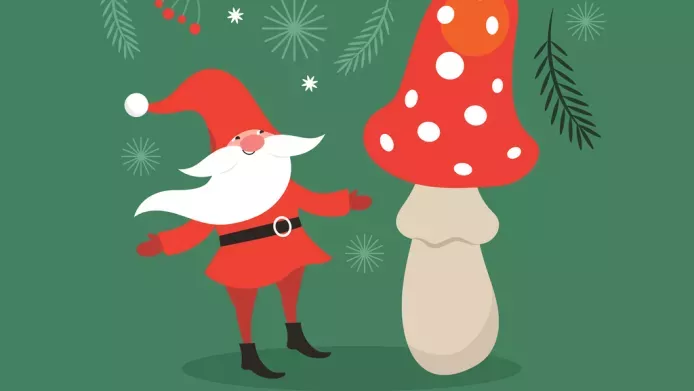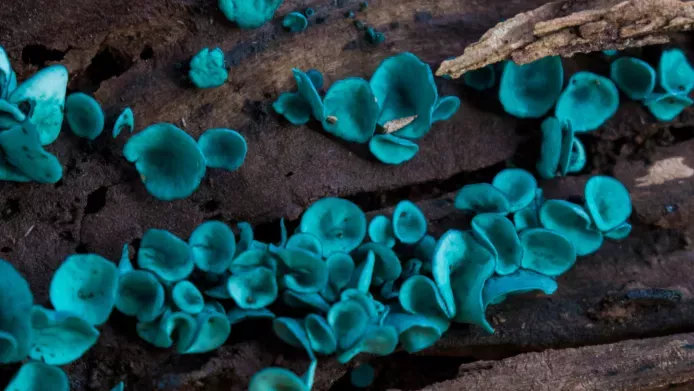Mushrooms, with their unique appearances, have long been associated with mystery and enchantment. The fly agaric (Amanita muscaria) mushroom is particularly iconic in popular culture, often illustrated in children’s books as the magical home of fairies.
Is it a coincidence that it’s otherworldly red and white colours have come to be the colours of Christmas (think Father Christmas and candy canes)? It might be worth entertaining the idea that this small and mighty mushroom, represented in Christmas decorations and cards, has had more historical influence over the Christian celebration than we might think.
What is the fly agaric?
 © Grow Wild/ RBG Kew
© Grow Wild/ RBG Kew
The fly agaric fungus Amanita muscaria is native to Europe, Asia, and North America. It’s red and white mushrooms are commonly seen from late summer to early winter.
It gets its common name from its historic use as a fly catcher in Europe - it contains a toxin that attracts and then intoxicates flies. It has also been used for centuries across different continents in religious and recreational ceremonies, and it is said to have hallucinogenic properties.
Fly agaric mushrooms are poisonous and cause cramping, vomiting and risk of death when consumed by humans, although many animals can eat them unaffected.
Christmas mushrooms and Father Christmas

The legend of Father Christmas as we know him today is said to have originated in part from Lapland and Siberia, and it is possible that we have the fly agaric mushroom to thank for it.
For millennia, Shamans in the Siberian region have consumed fly agaric during spiritual celebrations, to enter trance-like states. Shamans would also give out samples of fly agaric mushrooms to people as a gift. Notably, it is thought they would wear red and white clothes, mimicking the colours of the mushrooms.
The shamanic tradition of consuming fly agaric is also closely linked to reindeer, said to be one of their favourite foods. Intriguingly, people commonly consumed the urine of reindeer that had eaten fly agaric mushrooms as this method was believed to bypass the mushroom's toxicity whilst retaining its hallucinogenic effects. Reindeer have also been observed drinking the urine of humans who have consumed fly agaric. Maybe that’s how reindeer fly?
Was this beautiful but toxic mushroom where Father Christmas originated?
Remember: fly agaric mushrooms are poisonous and should not be eaten.
Gifts from underneath the tree
Fly agaric mushrooms grow in woodlands and heathlands, among Christmas trees (evergreen conifers such as pine or spruce).
Fly agaric can also form mycorrhizal relationships with trees. This means the fungi transport essential nutrients from the soil to the tree’s roots in exchange for carbon and nutrients. 90% of plants on earth rely on fungi that form mycorrhizal relationships. They are true gifts - the mirror image of the red and white wrapped presents underneath a Christmas tree.
It makes sense that when bringing trees and foliage inside to brighten homes during winter celebrations, the mushrooms beneath trees came in too.
A UK native Christmas tree
Although not commonly grown commercially for Christmas, the Scots pine (Pinus sylvestris) - the only pine tree native to Britain – can also become a Christmas tree.
Scots pine live most abundantly in the Scottish Highlands, supporting rare species such as red squirrels and pine martens, during what can be up to a 700-year life span. Their beautiful brown pinecones are often also used as Christmas decorations to hang on a tree or decorate a table.
Origins of the Christmas Tree
 Painting of Queen Victoria, Prince Albert and children in front of their Christmas tree, 1848. Image: public domain via Wikipedia Commons.
Painting of Queen Victoria, Prince Albert and children in front of their Christmas tree, 1848. Image: public domain via Wikipedia Commons.
The roots of the Christmas tree can be traced to regions with abundant evergreen forests, particularly in northern Europe. The modern Christmas tree, as we know it, emerged in the 16th century in Germany. The German princess Queen Charlotte, who married King George III in the mid-18th century, is credited with bringing the idea of the Christmas tree to Britain. Queen Victoria further popularized the tradition when an illustration of their family gathered around a decorated Christmas tree appeared in the Illustrated London News. This image captured the imaginations of people around the word and helped establish the Christmas tree as a beloved holiday symbol.
References and related resources:
Amanita muscaria: Ecology, Chemistry, Myths. Carboué, Q.; Lopez, M. Encyclopedia 2021, 1, 905-914. https://doi.org/10.3390/encyclopedia1030069
Unknowingly Celebrating a Mushroom: The Influence of the Fly Agaric on Modern Yuletide Celebration. Bouchard, M. BIOL421 @UNBC—Insects, Fungi and Society. 2017.
The Origins of Santa...Maybe. | Office for Science and Society - McGill University. Joe Schwarcz PhD, 20 Dec 2018
More from the blog


